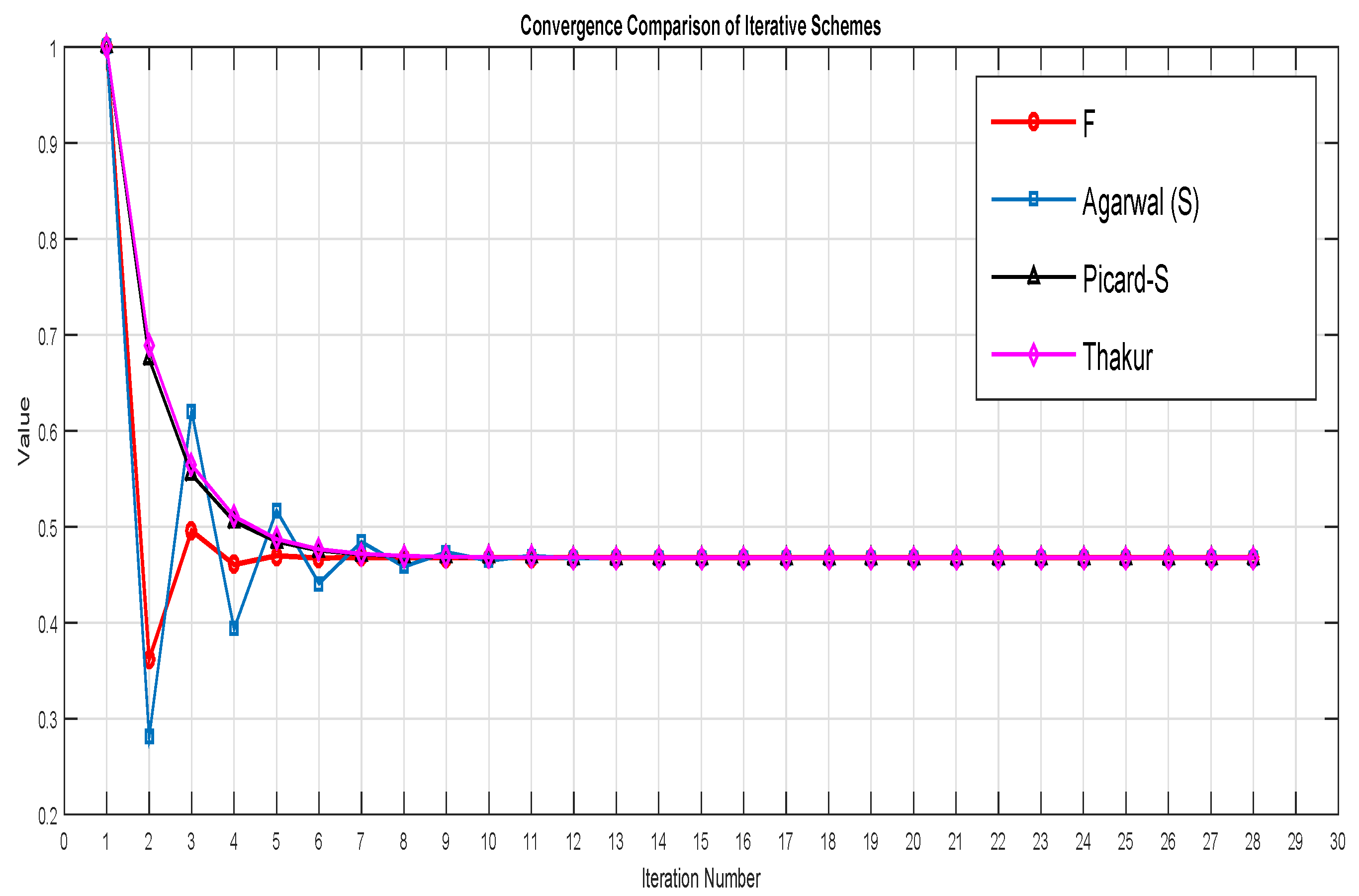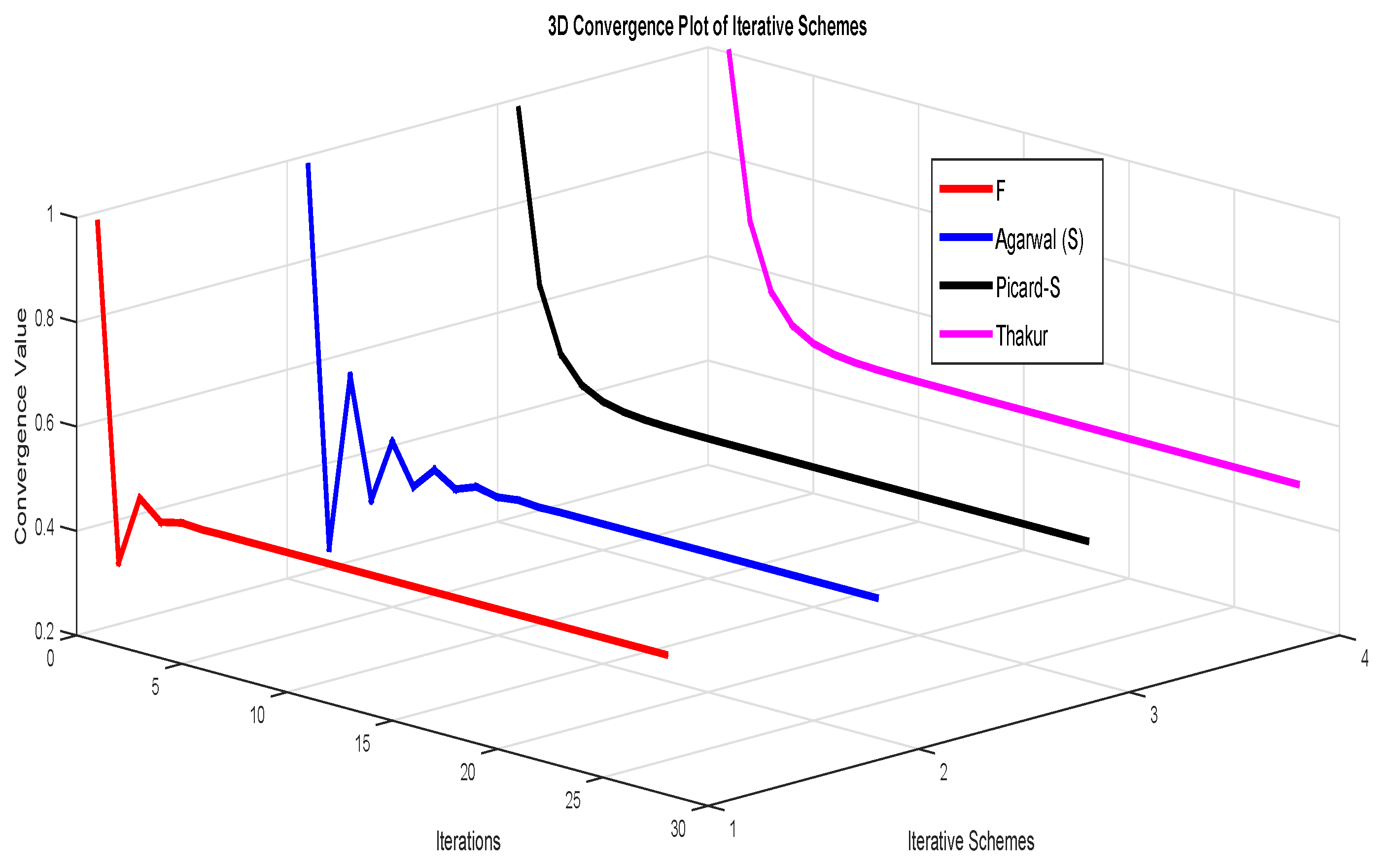Fixed Point Approximation for Enriched Suzuki Nonexpansive Mappings in Banach Spaces
Abstract
1. Introduction
- Section 2 provides preliminary definitions, concepts, and necessary lemmas related to fixed point theory, nonexpansive mappings, and the enriched condition. These foundational results are essential for understanding the main contributions of this paper.
- Section 3 presents the main results on the weak and strong convergence of the proposed iterative scheme. Theorems and proofs are provided to establish the validity of the iterative process under certain conditions.
- Section 4 includes a numerical example demonstrating the behavior of mappings that satisfy the enriched condition but not the ordinary condition. This section also compares the convergence rates of different iterative schemes using graphical representations.
- Section 5 applies the main theoretical findings to the split feasibility problem (SFP). A new projection type iterative method is introduced, and its convergence properties are analyzed in the context of Hilbert spaces.
- Section 6 concludes this paper by summarizing the key contributions and suggesting potential directions for future research, including further extensions of the iterative scheme and applications in broader mathematical frameworks.
2. Preliminaries
- ,
- for all ,
- 1.
- If P satisfies the (C) condition, then, for all , the inequalityholds.
- 2.
- Suppose P satisfies the Suzuki (C) condition and U satisfies Opial’s condition. If for any sequence that converges weakly to a point , the conditionholds, then .
3. Main Results
4. Numerical Results
5. Application
6. Conclusions
Author Contributions
Funding
Institutional Review Board Statement
Data Availability Statement
Acknowledgments
Conflicts of Interest
References
- Brouwer, L.E.J. Über Abbildung von Mannigfaltigkeiten. Math. Ann. 1911, 71, 97–115. [Google Scholar] [CrossRef]
- Lefschetz, S. On the fixed point formula. Ann. Math. 1937, 38, 819–822. [Google Scholar] [CrossRef]
- Hitchin, N.J. The self-duality equations on a Riemann surface. Proc. Lond. Math. Soc. 1987, 55, 59–126. [Google Scholar] [CrossRef]
- Hausel, T.; Thaddeus, M. Mirror symmetry, Langlands duality, and the Hitchin system. Invent. Math. 2003, 153, 197–229. [Google Scholar] [CrossRef]
- Anjum, R.; Abbas, M. Common fixed point theorem for modified Kannan enriched contration pair in Banach spaces and its applications. Filomat 2021, 35, 2485–2495. [Google Scholar] [CrossRef]
- Basarir, M.; Sahin, A. On the strong and Δ-convergence of S-iteration process for generalized nonexpansive mappings on CAT(0) space. Thai J. Math. 2014, 12, 549–559. [Google Scholar]
- Sahin, A. Some new results of Miteration process in hyperbolic spaces. Carpathian J. Math. 2019, 35, 221–232. [Google Scholar] [CrossRef]
- Browder, F.E. Nonexpansive nonlinear operators in a Banach space. Proc. Natl. Acad. Sci. USA 1965, 54, 1041–1044. [Google Scholar] [CrossRef] [PubMed]
- Gohde, D. Zum Prinzip der Kontraktiven Abbildung. Math. Nachrichten 1965, 30, 251–258. [Google Scholar] [CrossRef]
- Suzuki, T. Fixed point theorems and convergence theorems for some generalized nonexpansive mappings. J. Math. Anal. Appl. 2008, 340, 1088–1095. [Google Scholar] [CrossRef]
- Abbas, M.; Ali, B.; Vetro, C. A Suzuki type fixed point theorem for a generalized multivalued mapping on partial Hausdorff metric spaces. Topol. Appl. 2013, 160, 553–563. [Google Scholar] [CrossRef]
- Berinde, V. Approximating fixed points of enriched nonexpansive mappings by Krasnoselskij iteration in Hilbert spaces. Carpathian J. Math. 2019, 35, 293–304. [Google Scholar] [CrossRef]
- Ullah, K.; Ahmad, J.; Arshad, M.; Ma, Z. Approximation of fixed points for enriched Suzuki nonexpansive operators with an application in Hilbert spaces. Axioms 2022, 11, 14. [Google Scholar] [CrossRef]
- Picard, E.M. Mémoire sur la théorie des équations aux dérivées partielles et la méthode des approximations successives. J. Math. Pure Appl. 1890, 6, 145–210. [Google Scholar]
- Banach, S. Sur les opérations dans les ensembles abstraits et leur application aux équations intégrales. Fundam. Math. 1922, 3, 133–181. [Google Scholar] [CrossRef]
- Abbas, M.; Nazir, T. A new faster iteration process applied to constrained minimization and feasibility problems. Math. Vesnik 2014, 66, 223–234. [Google Scholar]
- Agarwal, R.P.; O’Regon, D.; Sahu, D.R. Iterative construction of fixed points of nearly asymptotically non-expansive mappings. J. Nonlinear Convex Anal. 2007, 8, 61–79. [Google Scholar]
- Ali, J.; Jubair, M.; Ali, F. Stability and convergence of F iterative scheme with an application to the fractional differential equation. Eng. Comput. 2020, 38, 693–702. [Google Scholar] [CrossRef]
- Alshehri, M.G.; Khan, F.A.; Ali, F. An iterative algorithm to approximate fixed points of non-linear operators with an application. Mathematics 2022, 10, 1132. [Google Scholar] [CrossRef]
- Ishikawa, S. Fixed points by a new iteration method. Proc. Am. Math. Soc. 1974, 44, 147–150. [Google Scholar] [CrossRef]
- Mann, M.R. Mean value methods in iteration. Proc. Am. Math. Soc. 1953, 4, 506–510. [Google Scholar] [CrossRef]
- Noor, M.A. New approximation schemes for general variational inequalities. J. Math. Anal. Appl. 2000, 251, 217–229. [Google Scholar] [CrossRef]
- Ali, F.; Ali, J. Convergence, stability and data dependence of a new iterative algorithm with an application. Comp. Appl. Math. 2020, 39, 667. [Google Scholar] [CrossRef]
- Thakur, B.S.; Thakur, D.; Postolache, M. A new iterative scheme for numerical reckoning fixed points of Suzuki’s generalized nonexpansive mappings. Appl. Math. Comput. 2016, 275, 147–155. [Google Scholar] [CrossRef]
- Abdeljawad, T.; Ullah, K.; Ahmad, J.; Ma, Z. On the convergence of an iterative process for enriched Suzuki nonexpansive mappings in Banach spaces. AIMS Math. 2022, 7, 20247–20258. [Google Scholar] [CrossRef]
- Gursoy, F.; Karakaya, V. A Picard-S hybrid type iteration method for solving a differential equation with retarded argument. arXiv 2014, arXiv:1403.2546v2. [Google Scholar]
- Ali, J.; Ali, F. A new iterative scheme for approximating fixed points with an application to delay differential equation. J. Nonlinear Convex Anal. 2020, 21, 2151–2163. [Google Scholar]
- Ullah, K.; Arshad, M. Numerical reckoning fixed points for Suzuki’s generalized nonexpansive mappings via new iteration process. Filomat 2018, 32, 187–196. [Google Scholar] [CrossRef]
- Agarwal, R.P.; O’Regon, D.; Sahu, D.R. Fixed Point Theory for Lipschitzian-Type Mappings with Applications; Topological Fixed Point Theory and Its Applications; Springer: New York, NY, USA, 2009. [Google Scholar]
- Takahashi, W. Nonlinear Functional Analysis; Yokohoma Publishers: Yokohoma, Japan, 2000. [Google Scholar]
- Opial, Z. Weak and strong convergence of the sequence of successive approximations for nonexpansive mappings. Bull. Am. Math. Soc. 1967, 73, 591–597. [Google Scholar] [CrossRef]
- Senter, H.F.; Dotson, W.G. Approximating fixed points of non-expansive mappings. Proc. Am. Math. Soc. 1974, 44, 375–380. [Google Scholar] [CrossRef]
- Ullah, K.; Ahmad, J.; Sen, M.D. Some new results on a three-step iteration process. Axioms 2020, 9, 110. [Google Scholar] [CrossRef]
- Schu, J. Weak and strong convergence to fixed points of asymptotically nonexpansive mappings. Bull. Aust. Math. Soc. 1991, 43, 153–159. [Google Scholar] [CrossRef]
- Clarkson, J.A. Uniformly convex spaces. Trans. Am. Math. Soc. 1936, 40, 396–414. [Google Scholar] [CrossRef]
- Censor, Y.; Elfving, T. A multiprojection algorithm using Bregman projections in a product space. Numer. Algorithms 1994, 8, 221–239. [Google Scholar] [CrossRef]
- Byrne, C. A unified treatment of some iterative algorithms in signal processing and image reconstruction. Inverse Prob. 2004, 20, 103–120. [Google Scholar] [CrossRef]


| Sr. No. | F | Agarwal (S) | Picard-S | Thakur |
|---|---|---|---|---|
| 1 | 1.000000 | 1.000000 | 1.000000 | 1.000000 |
| 2 | 0.361946 | 0.280523 | 0.674841 | 0.688141 |
| 3 | 0.495765 | 0.620713 | 0.554422 | 0.564395 |
| 4 | 0.460531 | 0.393557 | 0.505470 | 0.510906 |
| 5 | 0.469798 | 0.516776 | 0.484500 | 0.487153 |
| 6 | 0.467323 | 0.440975 | 0.475280 | 0.476516 |
| 7 | 0.467986 | 0.484251 | 0.471176 | 0.471741 |
| 8 | 0.467808 | 0.458440 | 0.469340 | 0.469596 |
| 9 | 0.467855 | 0.473438 | 0.468517 | 0.468632 |
| 10 | 0.467843 | 0.464592 | 0.468147 | 0.468199 |
| 11 | 0.467846 | 0.469762 | 0.467981 | 0.468004 |
| 12 | 0.467845 | 0.466725 | 0.467906 | 0.467917 |
| ⋮ | ⋮ | ⋮ | ⋮ | ⋮ |
| 20 | 0.467845 | 0.467830 | 0.467845 | 0.467845 |
| ⋮ | ⋮ | ⋮ | ⋮ | ⋮ |
| 28 | 0.467845 | 0.467845 | 0.467845 | 0.467845 |
Disclaimer/Publisher’s Note: The statements, opinions and data contained in all publications are solely those of the individual author(s) and contributor(s) and not of MDPI and/or the editor(s). MDPI and/or the editor(s) disclaim responsibility for any injury to people or property resulting from any ideas, methods, instructions or products referred to in the content. |
© 2025 by the authors. Licensee MDPI, Basel, Switzerland. This article is an open access article distributed under the terms and conditions of the Creative Commons Attribution (CC BY) license (https://creativecommons.org/licenses/by/4.0/).
Share and Cite
Filali, D.; Alamrani, F.M.; Alshaban, E.; Alatawi, A.; Alanazi, A.Y.; Khan, F.A. Fixed Point Approximation for Enriched Suzuki Nonexpansive Mappings in Banach Spaces. Axioms 2025, 14, 426. https://doi.org/10.3390/axioms14060426
Filali D, Alamrani FM, Alshaban E, Alatawi A, Alanazi AY, Khan FA. Fixed Point Approximation for Enriched Suzuki Nonexpansive Mappings in Banach Spaces. Axioms. 2025; 14(6):426. https://doi.org/10.3390/axioms14060426
Chicago/Turabian StyleFilali, Doaa, Fahad Maqbul Alamrani, Esmail Alshaban, Adel Alatawi, Amid Yousef Alanazi, and Faizan Ahmad Khan. 2025. "Fixed Point Approximation for Enriched Suzuki Nonexpansive Mappings in Banach Spaces" Axioms 14, no. 6: 426. https://doi.org/10.3390/axioms14060426
APA StyleFilali, D., Alamrani, F. M., Alshaban, E., Alatawi, A., Alanazi, A. Y., & Khan, F. A. (2025). Fixed Point Approximation for Enriched Suzuki Nonexpansive Mappings in Banach Spaces. Axioms, 14(6), 426. https://doi.org/10.3390/axioms14060426






